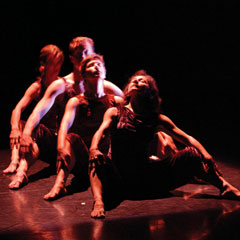Fringe Shorts: Men and Women
Lightsey Darst reviews Men and Women by the Gomez Dance Group: she finds it well-crafted with little artistry. What does this mean? Read on. See the show Fri, 8/11, at 5:30; or Sat, 8/12, at 7, at the Southern Theater.

The three dances in Men and Women show a certain form of modern dance: shape-oriented yet driven by momentum (which may be real or faked); using open, healthy-looking poses; moving mostly at an even tempo, with the music; performed with sincerity and without speech, clever props, or any other postmodern non-dance moments; based on a story or situation, with a clear emotional impulse.
I wouldn’t call this style venerable, given that modern itself is only about a hundred years old, but it’s certainly been around long enough to be instantly recognizable—and it’s also been around long enough that any pleasant novelty or tingling contemporaneity has worn off. This year, 2006, doesn’t particularly feel like this style, in other words, and so the flaws of Maria Gomez Tierney’s dances practically glow.
Her choreography’s stilted; foursquare rhythms, with one step per note, are terribly unforgiving, and even an excellent dancer like Eric Boone can’t create flow where there’s none to begin with. The “health” of the movements—that is, they’re not contorted, sexy, neurotic, or breathlessly suspended—bores. The emotional courses of these pieces are, mostly, trite: in a piece which is actually titled “Women,” a group of women frolic and vamp, but without crossing the line into real and dangerous sexuality. It’s hard to figure out, really, why Men and Women is appearing now, when work so much like it has appeared so often before. Where is the original, personal impulse to create this work?
I thought I found it in a couple of places. First, in the slow, lazing beginning to “Touched,” in which Boone and Rob Leadley lounge across each other, one almost architecturally raising a hand and the other soothing it back down again. Something here, something indefinable, threatens to unfold—but then Tierney raises her dancers from the floor and starts up the familiar modern dance. It’s as if Tierney doesn’t trust this meditative, gestural, almost not touching, almost not dancing dance, though this is where the piece’s passion and restraint come alive. The scenario for “Borderland” is a puzzle: a couple (Boone and Lynn Hoffman) are initially blessed by another woman (Tierney), then watch warily as her mood darkens. Is she depressed and self-destructive? Jealous? Is she meant to represent something about the apparently southwestern land (to judge by the costumes) where this piece takes place? None of this is clear. But it’s interesting, it’s individual, and it calls for further development.
Why do I demand an original, personal impulse? Why can’t a choreographer (or other artist) simply create within a style? It’s not (I hope) that I’m demanding the shock of the new, or that I want autobiographical work. It’s the line between craft and art: creation within a style established by others is craft. Painting like Vermeer is craft. But art does not fit inside; art disturbs and remakes the existing world.